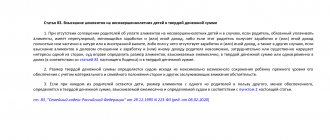6
Many women who have experienced a divorce are interested in the issue of calculating child support. The main difficulties in calculating alimony are related to the timing of collection, as well as the amount due to the recipient of alimony for the maintenance of children.
The family legislation of the Russian Federation gives the following definition of the concept of alimony - amounts of money or payment in kind for the maintenance of children until they reach adulthood, paid to those parents who live separately from the children.
Child support is paid in accordance with the following regulations:
- RF IC. Establishes the right of children to receive financial support from their parents.
- Federal Law No. 229 of October 2, 2007 “On enforcement proceedings.” Regulates the procedure for withholding money by state enforcement agents (bailiffs).
- Decree of the Government of Russia No. 841 of July 18, 1996. This act establishes the types of income from which alimony is calculated.
How much income is alimony paid from?
This issue is regulated by Resolution No. 841. The salary is calculated from:
- wages;
- bonuses and other rewards (in cash and in kind);
- payments to civil servants and persons equivalent to them;
- fees for media employees, literary authors, and arts workers;
- payments to health workers and teachers;
- other remunerations provided for in the employment relationship (for example, compensation for food or travel);
- allowances and surcharges.
Important! Alimony is not taken from payments due to the parent in connection with the birth of a child, marriage, survivor's pension, compensation for business trips, transfer to another position or to another region, as well as payments for depreciation of a vehicle or instrument that is the property of the alimony payer. If the payer himself receives alimony, payments are not made from them.
The above resolution also provides for the withholding of funds from:
- profit received by a private entrepreneur;
- income from renting out an apartment;
- dividends (if the payer has a deposit or securities);
- payments under shares and agreements (for example, contracts);
- profits from the sale of copyright;
- income of a lawyer, notary, attorney.
What determines the amount of child support for one child?
The simplest answer would be: “On the level of the father’s income and the goodwill shown by him.”
The law does not set the exact amount, and the interest rate depends on many factors. Starting from whether the ex-husband’s salary is “white” and ending with the composition of his family. For example, if this is not his first divorce, and previous families also have children, instead of the legally established 25% of the father's income, your child may receive 16.5% or even less.
The most civilized way is to enter into a voluntary alimony agreement during a divorce. Parents find the optimal amount that will satisfy the child’s needs and will not infringe on the rights of his father. Voluntary alimony may be higher than what the court would order in a similar situation. Plus it's convenient. If alimony by court order or court decision must be paid in a strictly defined manner, then with voluntary support the parents can agree on a more comfortable regime for each. For example, contractual alimony can be paid in advance, several months in advance.
The only thing that is not allowed when drawing up a voluntary alimony agreement is setting the amount of monthly payments too low. The magistrate’s court will simply not approve it if it considers that the child’s rights have been violated.
When the amount of alimony is determined by the court, it is guided by Article 113 of the Family Code and the Federal Law “On Enforcement Proceedings” (Federal Law No. 229). In this case, the amount of income of the alimony payer, his state of health and marital status, and the specific needs of the child are taken into account.
If a child has a chronic illness that requires treatment and rehabilitation, the amount of child support may be increased. If, on the contrary, the father is chronically ill, unemployed, burdened with disabled elderly parents or a disabled child in another marriage, alimony can be calculated even in the amount of 25% or 16.5% of 0.1 subsistence level (ML).
Procedure and rules for calculating alimony
You can agree on an amount of financial support for the children that is acceptable to both parents by drawing up a child support agreement. If the former spouses cannot reach an agreement, the procedure for calculating child support is determined by the court.
Payment agreement
Having drawn up an agreement, parents can provide not only the amount of maintenance and terms of payments, but also calculate the annual indexation of the amount of alimony.
By agreement, the parents themselves have the right to determine the amount and procedure for paying alimony, but the amount of alimony under the agreement cannot be less than the amount that the child could claim if forced to collect alimony through the court.
| No. | Collection options | A comment |
| 1 | As a share of income | The agreement specifies the size of the share of all income of the payer's parent, but not less than the amounts established by law. For example, for 1 child, the amount of alimony cannot be less than 2% of all types of income. |
| 2 | Fixed | A fixed monetary amount is established, which cannot be less than the one that would be established by the court. |
| 3 | One-time | If the father has a large sum of money, part of a business, a bank account or real estate, the spouses have the right to agree on a one-time payment of child support. The total value of the property cannot be less than the total amount of alimony that the child could receive before the age of 18. |
The agreement to pay alimony is certified by a notary after checking compliance with the rights of minor children.
Judicially
If the former spouses do not agree, they go to court.
By court decision, alimony is assigned:
- in a fixed amount;
- percentage of the payer’s income;
Important! There are no “suspensive” court decisions, when a certain amount is withheld from the payer, and after a change in circumstances, a percentage of the profit. It also cannot be stated that if certain circumstances change, the amount of alimony is subject to change.
Read more about the judicial procedure for collecting alimony here.
How to apply for child support for parental support?
Ideally, in order for parents to be able to receive regular financial assistance from their child, all that is required is a voluntary agreement that the children undertake to pay monthly alimony for the maintenance of their parents in one or another amount agreed upon by the parties.
“In order to conclude an alimony agreement, you need to contact a notary, since it must not only be drawn up in writing, but also notarized,” says Ekaterina Antonova. — In this case, the document must contain information about the amount of alimony for the maintenance of parents, as well as the terms, procedure and other conditions of these payments. In this case, the agreement must be signed by both parties. If at least one of the signatures or notarization is missing, this document may be declared invalid.”
To enter into an agreement, the parent and child must have their passports and the child’s birth certificate to prove their relationship. In addition, the child must present a certificate from his place of work, which will contain the amount of his earnings for the last three months of work.
pixabay.com/
In solid size
To determine the amount of child support, the court takes into account the coefficient (0.5,1, 1.5), multiplied by the cost of living for a child of a certain age, depending on the region of residence.
Example. According to the court decision, M.’s father is obliged to transfer 0.5 times the subsistence minimum monthly for the maintenance of his three-year-old daughter. In the Yaroslavl region, where my daughter lives, the cost of living for children is set at 9,648 rubles. Thus, my daughter is entitled to 4,824 rubles a month.
For comparison, a similar court decision was made in the Irkutsk region for the maintenance of a five-year-old son with a coefficient of 0.5 of the subsistence minimum, which in this region is 10,388 rubles. Thus, the son is entitled to 5194 rubles.
A clear amount of child support should be established if the payer’s income is difficult to estimate. For example, in the case of calculating wages in foreign currency, conducting business activities.
The selected coefficient varies depending on the financial situation of the payer, the recipient, the number of children who are entitled to maintenance, and the presence of other dependents of the payer.
Attention! After analyzing judicial practice, we can conclude that most judges award alimony for one child in the amount of the subsistence level of the region of residence. However, not all courts support this practice.
If maintenance is paid based on the agreement of the parents, they themselves determine its amount. The main thing is that it should not be less than the amount provided for by law.
Child support for parents: judicial practice from an expert
In 2010, citizen B. exercised the legal right to file a claim in court against her adult son A. to collect 10 thousand rubles from him monthly for her maintenance. To substantiate her claims, the citizen indicated that she is not just his mother, but also a pensioner and a disabled person of group 2-1, and also suffers from various diseases and needs care and the purchase of medicines. At the same time, her only income is an old-age pension, and her son refuses to voluntarily help her. The defendant did not appear at the court hearing and did not admit the claims. At the same time, the magistrate refused to satisfy citizen B.’s claim.
Having checked the case materials and considered the arguments set out in the supervisory appeal, the supervisory court found the court decisions subject to cancellation on the following grounds:
- the court did not take into account the provisions of the Constitution of the Russian Federation, which establish the unconditional and primary duty of adult able-bodied children to provide for their disabled parents in need. In addition, the financial situation and family circumstances of the children do not matter, since the transfer of alimony is within the scope of their constitutional responsibilities;
- the court did not allow the parties to discuss the issue of the relationship between the plaintiff’s needs and her income: the fact that citizen B. has a pension and also enjoys periodic support from the state due to disability does not serve as a reason for refusing her alimony.
Taking into account the above, B.’s civil case was sent for a new trial with a different composition of judges. As a result, the claim for alimony was satisfied.
Percentage of earnings
The calculation of alimony as a share (percentage) of earnings occurs on the basis of Article 81 of the RF IC. Shared payment of allowance is possible if the father is officially employed and has a regular income.
For 1 child
According to the law, a quarter (25%) of the payer’s total income is calculated for one child, which includes the income listed above.
Attention! The minimum wage is established by Federal Law-460. It is 7800 rubles. Accordingly, the minimum allowance for one child will be 7800 * 1/4 = 1950 rubles. It is possible that the payer may not officially work full-time, paid in an amount less than the established subsistence level. In this case, the amount of alimony will be even less.
For 2 children
If two minor children remain with the mother, one third (33%) is withheld from the father’s salary. If you calculate the amount of maintenance for two children at the minimum wage, it will be: 7800 * 1/3 = 2575 rubles.
For 3 or more children
If the payer has three or more young children, half (50%) is withheld from his salary.
With minimum earnings, the amount of alimony for three will be 3,900 rubles.
The court may increase the amount of alimony payments if the mother manages to prove that the child especially needs money for treatment or due to a serious illness and deplorable financial situation. The maintenance can be reduced at the request of the payer and only in exceptional cases.
Example. Suppose citizen K. has one child, and citizen M. has three. They work at the same enterprise and receive the same salary - 15,000 rubles. Since men work officially and have a stable income, the court, guided by Article 81 of the RF IC, assigned alimony as a percentage of earnings:
- For K. – ¼;
- For M – ½.
Thus, for the maintenance of a child, citizen K. will be deducted 3,750 rubles, and citizen M. – 7,500 rubles (2,500 rubles for each child).
When drawing up a child support agreement, parents can increase the percentage of income due to the child as maintenance. But it cannot be reduced.
Does the right to alimony apply to citizens living in other countries?
Article 118 of the RF IC indicates that if a citizen leaves for permanent residence in another state, then he is also entitled to voluntarily sign an agreement on the transfer of alimony with those family members whom he needs to support on the basis of the law.
“If an agreement is not reached, then, by analogy with the previous situation, the interested person has the right to come with an application to the court, demanding that the amount of alimony be established and its collection by transferring him a lump sum payment, providing one or another property as payment, or in some other way, provided for by law,” explains Ekaterina Antonova.
Payment of alimony to the recipient
Alimony is paid to the person specified in the application or writ of execution. The required amount can be issued from the organization’s cash desk or transferred to the recipient’s account, as well as transferred by mail or transferred to the account of the enforcement authority.
Alimony must be paid within 3 days starting from the day following the day of payment of the income from which alimony is withheld.
Please note: If alimony is transferred via mail, the costs of the transfer are borne by the employee.
To account for alimony payments, subaccount 76-1 “Settlements under writs of execution” of account 76 “Settlements with various debtors and creditors” is intended.
Indexing
The settlement agreement must necessarily stipulate the condition for indexing alimony payments. Otherwise, the process of indexation of payments will be regulated by the norms set out in Article 117 of the Family Code of the Russian Federation. The article establishes the need to index alimony:
- Payments are indexed in proportion to the increase in the cost of living for certain socio-demographic groups of the country's population. The minimum cost of living is established in each subject of the state. In turn, the subject is determined by the place of residence of the recipient of the payments.
- Payments for child are indexed in proportion to the increase in the cost of living for socio-demographic groups for the country as a whole (the measure is taken into account if the minimum amount is not provided in the constituent entity of the Russian Federation).
Alimony, which is paid on the basis of a court decision, is also subject to indexation in accordance with similar rules.
Collection procedure
Voluntary payments by agreement of the parties are made based on the application of the one who will pay. It must indicate, in addition to general details (company name, full name, TIN and other necessary details of the payer, recipient):
- Full name of the child, age when making payments to a minor;
- types of accruals from which deduction must be made;
- the amount of withholding as a percentage or in the amount established by the parties;
- from what date to hold;
- when to transfer;
- recipient's bank details.
In all other cases, it is recommended to follow a certain procedure when working with alimony:
- Register a writ of execution (court order, notarial agreement) in the accounting department.
- Calculate and withhold alimony.
- Transfer the amount to the claimant.
- Return the writ of execution to the claimant or bailiff with a note.
Documents received for collection are registered in a special journal. The form of the journal is not strictly established, but Appendix No. 1 to the FSSP Methodological Recommendations No. 01-16 dated 06/19/12 states that it should be in the organization. It is recommended to include the following columns in the journal:
- name of the document, who issued it, date;
- when received, incoming number;
- Full name, address of the debtor;
- Full name, address of the person to whom the money is transferred;
- debtor's signature;
- retention amount;
- total amount of debt;
- Full name and signature of the employee who received the document (accountant);
- when and where the document was sent;
- Full name and signature of the employee who sent the document.
Bailiffs can send to the organization a copy of the writ of execution (amendments in accordance with Federal Law No. 101 dated 28/05/17, art. 2, clause 4-a). In all other cases, for example, if the claimant himself applied, the original is needed.
Executive documents must be stored in a safe, as strict reporting forms. The debtor must be notified of the receipt of the sheet for signature (a separate column is provided for this in the journal). A written notification of receipt must also be sent to the FSSP on the day the document arrived at the organization: date of receipt, its incoming number.
If an employee asks in advance, before the writ of execution is received, to begin withholding alimony from him, it is better not to do this or ask him for an application for a voluntary transfer of money - such transfers cannot be included in reducing the debt under the writ of execution.
The document usually indicates the date from which collection must begin. If it arrives at the accountant later, a debt will arise to the recipient. It is paid off by transferring the maximum percentage of the salary, not forgetting to pay off the current debt.
Alimony is usually transferred to the account of the claimant. It is indicated in the executive document or in the citizen’s application upon voluntary payment of the amount. This must be done within 3 working days from the date of payment of wages or other income (Article 109 of the RF IC). When sending, postage costs are taken in addition to the amount of alimony.
If the debtor quits, the writ of execution must be returned the next day after dismissal (Federal Law No. 229, Article 98, Clause 4.1). A note is made on it about the amount that has already been withheld, the reason for the termination of the withholding, the date: when the withholding began and when the return occurred. The return may be for other reasons, for example, the child has become an adult. They are also in paragraph 4 of this article.









